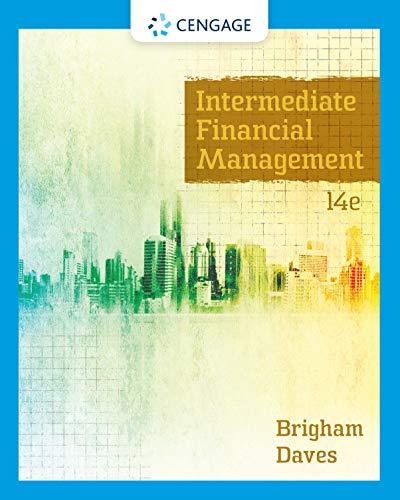David Lyons, CEO of Lyons Solar Technologies, is concerned about his firms level of debt financing. The
Question:
David Lyons, CEO of Lyons Solar Technologies, is concerned about his firm’s level of debt financing. The company uses short-term debt to finance its temporary working capital needs, but it does not use any permanent (long-term) debt. Other solar technology companies have debt, and Mr. Lyons wonders why they use debt and what its effects are on stock prices. To gain some insights into the matter, he poses the following questions to you, his recently hired assistant:
a. Who were Modigliani and Miller (MM), and what assumptions are embedded in the MM and Miller models?
b. Assume that Firms U and L are in the same risk class and that both have EBIT = $560,000. Firm U uses no debt financing, and its cost of equity is rsU =14%. Firm L has $1 million of debt outstanding at a cost of rd = 8%. There are no taxes. Assume that the MM assumptions hold.
(1) Find V, S, rs, and WACC for Firms U and L.
(2) Graph (a) the relationships between capital costs and leverage as measured by D/V.
(b) The relationship between V and D.
c. Now assume that Firms L and U are both subject to a 25% corporate tax rate. Using the data given in part b, repeat the analysis called for in parts b(1) and b(2) using assumptions from the MM model with taxes.
d. Suppose that Firms U and L have the same input values as in Part c except for debt of $980,000. Also, both firms have total net operating capital of $2,000,000 and both firms are expected to grow at a constant rate of 7%. Use the compressed adjusted present value (APV) model to estimate the value of U and L. Also estimate the levered cost of equity and the weighted average cost of capital.
e. Suppose the expected free cash flow for Year 1 is $250,000 but it is expected to grow faster than 7% during the next 3 years: FCF2 = $290,000 and FCF3 = $320,000, after which it will grow at a constant rate of 7%. The expected interest expense at Year 1 is $128,000, but it is expected to grow over the next couple of years before the capital structure
becomes constant: Interest expense at Year 2 will be $152,000, at Year 3 it will be $192,000 and it will grow at 7% thereafter. What is the estimated horizon unlevered value of operations (i.e., the value at Year 3 immediately after the FCF at Year 3)? What is the current unlevered value of operations? What is the horizon value of the tax shield at Year 3? What is the current value of the tax shield? What is the current total value? The tax rate and unlevered cost of equity remain at 25% and 14%, respectively.
f. Suppose Solar Technologies has no debt, its beta is 1.2, the risk-free rate is 4%, and the market risk premium is 6%. The tax rate is 25%. Lyons is considering restructuring to increase debt to a weight of 40%. If he does so, the debt he must issue will have an 8% rate of return. Lyons wants to know how this restructuring will impact Solar Tech’s required return on equity. He knows that there are 3 different models for this: Modigliani Miller with corporate taxes, Hamada, and the APV model. What do these three models say about Solar Tech’s required return on equity after the restructuring? Why are they different and which one should Lyons use?
g. How would your answer to Part f. be different if the information is the same but Solar Tech currently has 10% debt that has a rate of return of 7%?
Step by Step Answer:

Intermediate Financial Management
ISBN: 9780357516669
14th Edition
Authors: Eugene F Brigham, Phillip R Daves





